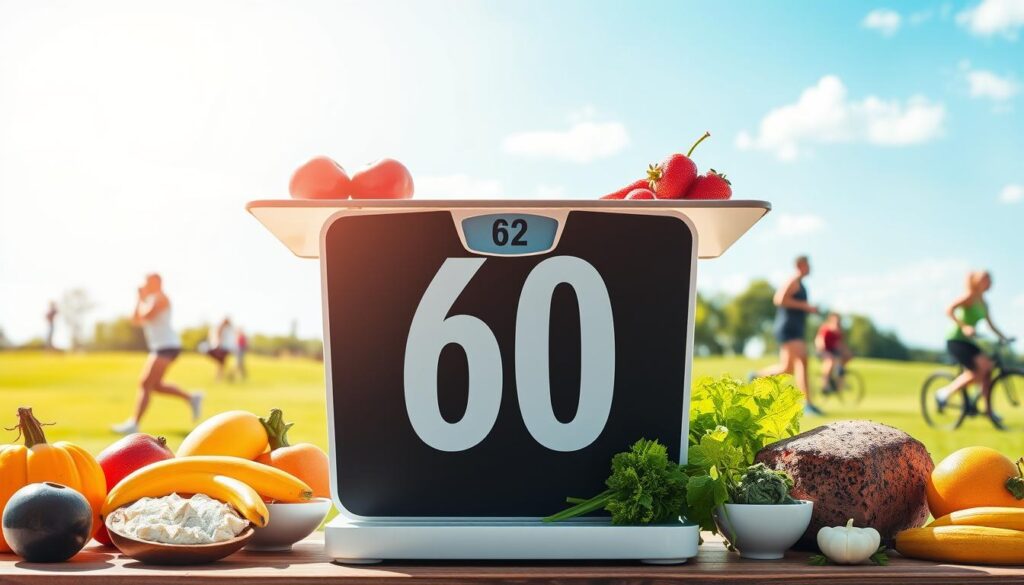Starting a weight loss journey to lose 60 pounds can seem hard. But, with the right steps and a whole-body approach, it’s doable. This guide will give you the tools and knowledge for lasting weight loss. It will help you change your body and boost your health.
Experts say a good weight loss goal is 1-2 pounds a week. Losing 2 pounds a week can help you lose 50 pounds in 6 months. With a bit more time, you can reach your 60-pound goal in over 7 months. The secret is to eat less and move more, but keep your health in mind.
Key Takeaways
- Achieve sustainable weight loss of 60 lbs by aiming for 1-2 lbs per week
- Create a calorie deficit of 500-1000 calories per day through diet and exercise
- Focus on building healthy habits and lifestyle changes for long-term success
- Incorporate a balanced approach of nutrition, exercise, and overall wellness
- Celebrate progress and be patient with the journey to reach your 60 lb weight loss goal.
Understanding the Weight Loss Journey
Starting a weight loss journey can feel hard. But knowing the science behind it can help you reach your goals. The main idea is to have a calorie deficit. This means burning more calories than you eat. A 3,500 calorie deficit is about losing one pound of fat.
So, aim to lose 1-2 pounds each week. This is a safe and steady pace.
The Science Behind Weight Loss
Many things can affect your weight loss, like your genes and stress. Finding the right diet and exercise can be tough. But, a calorie deficit of 500-1,000 calories daily is safe for losing weight.
It’s important not to eat too few calories. Women should not eat less than 1,200 calories. Men should not eat less than 1,500 calories without a doctor’s advice.
Setting Realistic Expectations
Changing your body takes time and effort. Don’t set goals that are too high. They might make you feel bad.
Instead, aim for small, easy goals. These will keep you motivated and on track.
Caloric Deficit Basics
To lose weight, you can eat less or move more. Or do both. Remember, a steady calorie deficit is important for lasting weight loss.
By understanding weight loss and setting realistic goals, you’re on your way to success.
“Persistence is key when it comes to sustainable weight loss. Slow progress is a typical part of the journey, but staying consistent with your efforts will pay off in the long run.”
Creating Your Personal Weight Loss Strategy
To lose weight, you need a plan that fits you. Work with a doctor to make a plan. It should include eating right, exercising, and living healthy.
Think about trying intermittent fasting. It can lower cholesterol and blood pressure. If you have fatty liver, a keto diet might help. Eat lots of good foods, but avoid bad carbs, fats, sugars, and processed foods.
Your diet should have proteins, fruits, veggies, whole grains, and healthy fats. This diet helps you lose weight and stay healthy.
| Strategies for Successful Weight Loss | Benefits |
|---|---|
| Intermittent Fasting | Reduced cholesterol, improved blood pressure |
| Ketogenic Diet | Beneficial for fatty liver disease |
| Balanced, Nutrient-Rich Diet | Supports weight loss and overall health |
Success in weight loss comes from finding a plan you can stick to. Work with a doctor to make a weight loss strategy, diet plan, and lifestyle changes that fit you. This will help you reach your weight loss goals.
Nutrition Fundamentals for Sustainable Weight Loss
To lose weight, you need to know about nutrition. Learn how to figure out your daily calorie needs. Also, balance your macronutrients and plan healthy meals. This way, you can make a diet plan that helps you lose weight.
Calculating Daily Caloric Needs
The first step is to find out how many calories you need each day. Use an online calculator or talk to a dietitian. They can help you figure out how many calories to cut to lose weight.
Try to cut 500 to 1,000 calories from what you normally eat. This helps you lose weight at a healthy pace.
Macro and Micronutrient Balance
It’s important to watch your calorie intake and eat the right foods. Make sure you get enough protein, carbs, and fats. Also, don’t forget vitamins, minerals, and fiber.
Eat foods like lean meats, whole grains, fruits, veggies, and healthy fats. This keeps you full and helps you lose weight.
Meal Planning and Portion Control
Plan your meals and control your portions. This helps a lot in losing weight. Make meals that are good for you and fit your diet plan.
Don’t follow diets that are too hard to stick to. Instead, make a diet plan that’s balanced and flexible. This way, you can enjoy treats sometimes too.
“The key to successful weight loss is to create a lifestyle that you can maintain for the long term. Restrictive diets often lead to feelings of deprivation and ultimately, weight regain. Embrace a balanced, nutrient-rich approach that you can stick to for life.”
By learning about nutrition and making a diet plan that’s right for you, you can reach your weight loss goals. You’ll also develop healthy eating habits that you can keep for life.
How to Lose Weight 60 lbs Through Exercise
Starting a fitness journey to lose 60 pounds is tough. But, the right exercise can help a lot. It’s important to mix cardio and strength training. This helps burn fat and build muscle.
Try to do 150-300 minutes of cardio each week. Or, do 75-150 minutes of hard cardio. Aim for 300 minutes to lose weight fast. Walk, jog, swim, or dance to make your workouts fun and good.
Don’t forget strength training. It helps build muscle and burn fat. Do strength training two times a week. This mix of cardio and strength is best for losing fat.
| Exercise Type | Recommended Weekly Duration |
|---|---|
| Moderate-intensity cardio | 150-300 minutes |
| Vigorous-intensity cardio | 75-150 minutes |
| Strength training | 2-3 sessions |
Remember, losing weight is a long journey. A balanced exercise routine helps you lose 60 pounds safely and slowly.
“I lost a significant amount of weight, around 60 pounds, in 3 months through exercise and dietary changes. The key was finding a routine that I enjoyed and could stick to consistently.”

Building Healthy Lifestyle Habits
Your weight loss journey is more than just numbers. It’s about making lifestyle changes and healthy habits for life. Getting enough sleep, managing stress, and drinking water are key steps.
Sleep and Recovery
Try to sleep 7-9 hours each night. Good sleep helps you lose weight. It stops belly fat from growing. Keep a regular sleep schedule and relax before bed.
Stress Management
Stress can hurt your weight loss. Find ways to relax like meditation or yoga. These activities help you handle stress and stay on track.
Hydration Guidelines
Drinking water is important for losing weight. Drink 4-6 cups a day, more if you’re active. Water helps you know when you’re thirsty, not hungry. Avoid sugary drinks that slow you down.
“Developing healthy lifestyle habits is the foundation for sustainable weight loss. It’s not just about the numbers on the scale; it’s about creating a balanced, nourishing, and fulfilling way of living.”
Remember, lifestyle changes are a journey. Focus on sleep, stress, and water to build healthy habits. These habits will help you on your weight loss journey and improve your health.
Tracking Progress and Making Adjustments
Starting your weight loss journey means watching your progress and making changes. It’s important to track your efforts. This helps you stay motivated and on track.
Use a food journal or a calorie app to track your food. Note down what you eat, how much, and your water intake. This helps you see patterns and find ways to get better. Studies show that tracking food leads to more weight loss.
Also, weigh yourself and take body measurements often. This lets you see how your body transformation is going. Remember, the scale isn’t everything. Look at how your body feels and your energy levels too.
When you see changes, you might need to tweak your plan. If you’re not losing weight or feeling stuck, look at your diet and exercise. Try small changes to see what works for you.
Tracking and adjusting your plan helps you reach your weight loss goals. Celebrate your wins and learn from any challenges. Keep improving your approach for a lasting body transformation.
“The secret of getting ahead is getting started. The secret of getting started is breaking your complex overwhelming tasks into small manageable tasks, and then starting on the first one.” – Mark Twain
| Metric | Initial | After 6 Months |
|---|---|---|
| Body Weight | 300 lbs | 240 lbs |
| Waist Measurement | 42 inches | 38 inches |

Overcoming Common Weight Loss Plateaus
Weight loss plateaus are normal in the fitness journey. Your body gets used to changes, making it harder to lose pounds. But, don’t give up – the right strategies can help you move forward and achieve your body transformation.
Understanding Body Adaptation
At first, you lose weight fast. This is because of glycogen and water loss. But, as you lose fat, your metabolism slows down. This can cause a weight loss plateau.
Studies show losing 5-10% of body weight can slow your metabolism by 15%. To beat this, you need to change your approach and keep challenging your body.
Adjusting Your Strategy
- Check your calorie intake and move more. Aim for 150 minutes of moderate exercise or 75 minutes of vigorous activity weekly, plus strength training.
- Eat more protein. It can help burn calories by 20-30%.
- Drink less alcohol. It can slow down fat burning and add belly fat.
- Eat more soluble fiber. It makes you feel full longer and helps avoid overeating.
Mental Resilience
Keeping a strong mind is key during a weight loss plateau. Focus on good energy, better sleep, and health gains. Remember, plateaus are short-lived. With the right changes and effort, you’ll see progress again.
Beating a weight loss plateau takes patience, flexibility, and a positive attitude. By understanding your body’s changes, adjusting your plan, and staying mentally strong, you can overcome this hurdle. Keep moving forward on your fitness journey towards your goals.
Maintaining Motivation and Support Systems
On your weight loss journey, staying motivated is key. Building a supportive network is as important as your diet and exercise. Weight loss motivation, a healthy lifestyle, and a strong fitness journey go hand in hand. By setting goals, creating a support system, and using tools, you can keep moving forward.
Focus on the actions you can take every day. This might be packing a healthy lunch, going for a walk, or drinking more water. Celebrating these small wins can keep you motivated and strong.
Surround yourself with people who support you. Share your journey with them and ask for help when you need it. Working with a health coach or dietitian can also offer valuable guidance and support.
Technology can be a big help too. Apps and fitness trackers can track your progress and help you stay on track. Seeing your efforts pay off can be a big motivator.
Remember why you started your weight loss journey. It might be for better health or more confidence. Stay focused on your goals and celebrate your successes. With persistence and kindness to yourself, you can reach your healthy lifestyle goals.
“Maybe the Diet failed you, you didn’t fail at the diet.”
| Metric | Men | Women |
|---|---|---|
| Bone | 15% | 10% |
| Muscle | 45% | 37% |
| Organs | 25% | 25% |
| Fat | 15% | 28% |
You’re not alone in your weight loss journey. Stories like Beverly’s and Sharon’s show success is possible. Stay focused, be kind to yourself, and enjoy the journey. Your health and happiness are worth it.
Conclusion
Losing 60 pounds is a big goal, but it’s doable. Focus on eating right and exercising often. This will help you start a journey to a healthier life.
Creating healthy habits is key. Get enough sleep, manage stress, and drink lots of water. These steps will help you reach your goal.
Keep track of your progress and stay motivated. Losing 60 pounds is a big challenge. But, it’s worth it for a better, happier you.


A Life-Changing Experience with This Weight Loss Supplement (Nagano Tonic)
I’ve always struggled with finding a weight loss solution that actually works for me. Like many, I’ve tried numerous diets, exercise routines, and supplements over the years—some worked for a short time, but nothing ever gave me long-term results. That was until I decided to try the weight loss supplement I found : Link to the Supplement.
From the moment I started using it, I noticed a difference. Not only did I feel more energized, but my cravings also became more manageable. The best part? I started seeing results much quicker than I anticipated! Over the course of just a few weeks, I noticed a significant reduction in belly fat and overall weight loss that I hadn’t been able to achieve before.
What makes this supplement stand out from all the others I’ve tried is how it supports me in my daily routine without any jitters or energy crashes. I’m able to stay focused and motivated, which has made it easier to stay on track with my diet and exercise plan.
This product truly exceeded my expectations, and I feel more confident and healthier than ever before. If you’re struggling with your weight loss journey like I was, I highly recommend giving this supplement a try. It’s been a game-changer for me, and I’m sure it can work wonders for you too!
Contant Them on email .. tonicnagano50@gmail.com
I’ve tried so many weight loss products over the years, but nothing worked like this supplement! Since I started using it, I’ve noticed a big difference in my energy levels and appetite control. In just a few weeks, I’ve lost weight and feel so much better. It’s been easy to stick with, and the results speak for themselves. Highly recommend this to anyone looking to make a real change!
wasn’t sure what to expect, but this weight loss supplement has really impressed me! After just a few weeks of use, I’ve already dropped a few pounds and feel more motivated to stay active. It’s helped curb my cravings and boosted my energy throughout the day. I’m excited to keep going and see even better results. Definitely worth trying!
Reach them on tonicnagano50@gmail.com
I was skeptical at first, but this supplement has truly made a difference in my weight loss journey. I’ve lost weight without feeling deprived or sluggish. My cravings are under control, and I feel more confident in my body. It’s easy to incorporate into my daily routine, and the results speak for themselves. I’m so glad I gave it a try!
Thanks David, i do use the link to make my purchase. you can get too here http://surl.li/iasppy
I’ve tried so many weight loss products, but this one has been by far the most effective. In just a few weeks, I’ve noticed a visible difference in my body and energy levels. It’s helped me stay on track without the constant hunger pangs and cravings. I’m really happy with my progress and can’t wait to see where I’ll be in another month!
This Nagano Tonic has been amazing! In just a few weeks, I’ve lost weight, feel more energized, and my cravings are under control. Highly recommend it!
Thats the link to purchase http://surl.li/iasppy